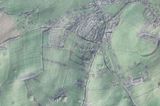
The underlying geology is Reading Beds, overlain with an inlier of London Clay. This has a strong influence on the extensive woodland cover and the high proportion of oak trees within the hedgerows. The area drains into the River Dun via a number of small streams. Small ponds and lakes are a feature of the area. Along the river Dun there is a number of springs. Some of these dry up during long hot summers but one or two are known as perpetual springs. One, for example, always produces water adjacent to Spring Cottage another, the Blue Lagoon, is on the river Dun (or Dunne) between West Dean and Holbury. Despite the proximity to the Dun it is rare for any flooding to take place. In part this is a consequence of careful maintenance and management of the sluices between Holbury Mill and Lockerley Mill.
Springs in the Lockerley area : a brief note by Cled Davies
The geology of this part of our local geography is a complex juxtaposition of geologically recent deposits belonging to the series Reading Formation. This in itself is a complex deposit of sandy clay, pebble beds and it is locally clay and glauconitic at its base. Above the Reading Formation is the younger London Clay Formation consisting of silty sandy clays, pebble beds and sand lenses.
Both formations lie uncomformably on the various chalk formations that we are familiar with surrounding the Hampshire Basin and Salisbury Plain.
For springs to occur the ideal conditions are a permeable, (porous or pervious) layer of strata above an impermeable layer. In our area these factors would be expected to occur where the younger sandier London Clay Formation overlies the older clay layers of the Reading Formation. The water table will fluctuate beneath these formations and it will fall from about May to September when evaporation exceeds precipitation and vice versa from October to April when precipitation and percolation exceed evaporation.
A very good example of spring line settlements on a bigger scale is where the chalk South Downs lie above the clay vales of the north edge of the South Downs.
Glossary of terms
The Reading Beds and London Clay belong to the upper section of the geological era called the Tertiary and sometimes called the Palaeogene. The period when they were deposited is called the Eocene from about 70 to 40 million years ago.
Unconformity: A break in the geological record, recognised where a set of rocks is overlain by another set which is not the next in the geological succession.
Water-Table: The upper surface of the zone of saturation in permeable rocks.
Glauconite: A blue-green coloured iron potassium phyllosilicate mica type of mineral which is a common component of greensand and has a marine origins. Go to Top
